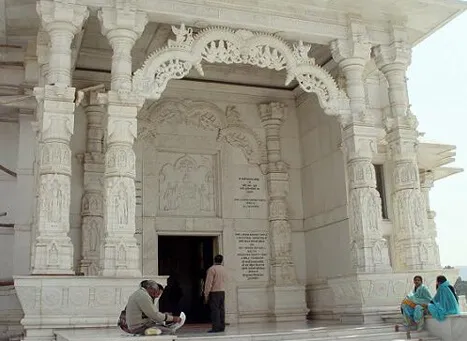
Laxminarayan Temple: A Majestic Shrine in Shekhawati
The Laxminarayan Temple in Shekhawati, Rajasthan, is a remarkable example of the region’s rich architectural and cultural heritage. Known for its historical significance and architectural grandeur, this temple is dedicated to Lord Vishnu and Goddess Laxmi, symbolizing prosperity and well-being.
Historical and Spiritual Significance
The Laxminarayan Temple stands as an important pilgrimage site in Shekhawati, reflecting the spiritual devotion of the local community. Dedicated to Lord Vishnu and Goddess Laxmi, the temple serves as a center of worship for those seeking blessings for prosperity and harmony.
Key Highlights of the Temple’s Significance:
Vishnu and Laxmi Worship: Lord Vishnu, the preserver of the universe, and Goddess Laxmi, the goddess of wealth and prosperity, are central figures in Hinduism. The temple’s dedication to these deities makes it an important site for worship and spiritual practice.
Historical Context: The temple is an integral part of Shekhawati’s historical and cultural landscape. Its construction reflects the artistic and architectural styles prevalent during its period, offering insights into the region’s history and religious traditions.
Architectural Features
Intricate Carvings and Artwork:
- The Laxminarayan Temple is renowned for its intricate carvings and detailed artwork. The temple’s façade and interiors are adorned with elaborate sculptures and frescoes that depict various Hindu deities and mythological scenes.
Main Sanctum:
- The central sanctum houses the idols of Lord Vishnu and Goddess Laxmi. The idols are meticulously crafted and are the focal point of worship. The sanctum is designed to accommodate various rituals and ceremonies performed by devotees.
Temple Complex:
- The temple complex typically includes a spacious courtyard, a prayer hall, and surrounding colonnades. The open spaces are designed to create a serene and contemplative environment for worship and meditation.
Rajasthani Architecture:
- The architectural style of the Laxminarayan Temple is characteristic of Shekhawati’s traditional Rajasthani design. It features ornate pillars, arches, and domes, reflecting the region’s artistic heritage.
Religious Practices and Festivals
Daily Rituals: The Laxminarayan Temple conducts various daily rituals and poojas (prayer ceremonies) dedicated to Lord Vishnu and Goddess Laxmi. Devotees visit the temple to offer prayers, perform rituals, and seek divine blessings.
Major Festivals: The temple celebrates major Hindu festivals such as Diwali (the festival of lights), Vishnu Jayanti, and Lakshmi Puja. These festivals are marked by special prayers, processions, and community celebrations.
Local Observances: The temple may also observe other local and regional festivals, providing opportunities for the community to come together and celebrate their faith.
Practical Information for Visitors
Timing: The Laxminarayan Temple is generally open to visitors throughout the day. Specific timings for rituals and ceremonies may vary, so it is advisable to check with local authorities or temple officials for accurate information before planning your visit.
Dress Code: Modest attire is recommended when visiting the temple. Visitors should wear clothing that covers the shoulders and knees. Removing shoes before entering the temple premises is required.
Photography: Photography inside the temple may be restricted to preserve its sanctity. It is best to inquire about the rules upon arrival or seek permission before taking photographs.
Respect: Observing respectful behavior is essential. This includes maintaining silence during prayers, avoiding disturbances, and following any guidelines set by the temple authorities.
Getting There
The Laxminarayan Temple is located in Shekhawati, which is well-connected by various modes of transportation:
By Road: Shekhawati is accessible by road from major cities in Rajasthan. You can travel to Shekhawati by taxi or bus from cities such as Jaipur (approximately 200 kilometers away) or Jodhpur (about 300 kilometers away). Local transport within Shekhawati can be used to reach the temple.
By Rail: The nearest railway station to Shekhawati is in Sikar or Jhunjhunu, which are major railway hubs in the region. From these stations, you can hire a taxi or use local transport to reach the Laxminarayan Temple.
By Air: The nearest airport to Shekhawati is in Jaipur, approximately 200 kilometers away. From Jaipur, you can travel to Shekhawati by road.
The Laxminarayan Temple in Shekhawati is a splendid example of Rajasthan’s spiritual and architectural heritage. With its intricate carvings, serene ambiance, and dedication to Lord Vishnu and Goddess Laxmi, the temple offers a meaningful experience for devotees and visitors. A visit to the Laxminarayan Temple provides an opportunity to connect with the deep spiritual traditions of Shekhawati and appreciate the region’s artistic and cultural richness.
